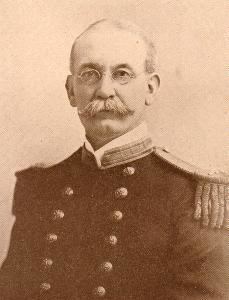Years of service 1862–1907 Role Oceanographer | Name Charles Sigsbee Rank Rear admiral Awards Alexander Agassiz Medal | |
 | ||
Born January 16, 1845Albany, New York ( 1845-01-16 ) Allegiance United States of America Commands held USS MaineUSS TexasSouth Atlantic Squadron Battles/wars American Civil War*Battle of Mobile Bay*First Battle of Fort Fisher*Second Battle of Fort FisherFormosan ExpeditionSpanish–American War*Sinking of the Maine*Second Battle of San Juan Books The "Maine", Deep-sea sounding and dredging | ||
Charles Dwight Sigsbee (January 16, 1845 – July 13, 1923) was a Rear Admiral in the United States Navy. In his earlier career he was a pioneering oceanographer and hydrographer. He is best remembered as the captain of the USS Maine, which exploded in Havana harbor, Cuba, in 1898. The explosion set off the events that led up to the start of the Spanish–American War.
Contents
Biography
Sigsbee was born in Albany, New York, and educated at The Albany Academy. He was appointed acting midshipman on 16 July 1862.
Sigsbee fought in numerous engagements during the Civil War, mostly against Confederate forts and batteries. Sigsbee served aboard the Monongahela, Wyoming, and Shenandoah from 1863 to 1869, when he was assigned to duty at the Naval Academy. In 1871, he was assigned to the Hydrographic Office. He was first posted to the Hydrographic Office in 1873. He was assigned to the Coast Survey in 1874 and commanded the Coast Survey steamer Blake 1875–1878. He returned to the Navy Hydrographic Office from 1878–1882 and served as Hydrographer in the Bureau of Navigation from 1893 to 1897. During his period on the Blake he developed the Sigsbee sounding machine which became a standard item of deep-water oceanographc equipment for the next 50 years.
Sigsbee served at the United States Naval Academy 1869–71, 1882–85, and 1887–90. He commanded the Kearsarge on the European station 1885–86 and the training ship Portsmouth 1891-92.
Sigsbee took command of the battleship Maine in April 1897. After the Maine was destroyed in February 1898, Sigsbee and his officers were exonerated by a court of inquiry. Subsequently he commanded the St. Paul in 1898 at the Second Battle of San Juan and Texas until 1900.
In February of that year he was appointed Chief Intelligence Officer of the Office of Naval Intelligence, succeeding Cmdr. Richardson Clover; he held this post until April 1903 when he was succeeded by Cmdr. Seaton Schroeder. He was promoted to Rear Admiral on 10 August 1903.
He assumed command of the South Atlantic Squadron in 1904, and the Second Division, North Atlantic Squadron in 1905.
Rear Admiral Sigsbee commanded the USS Brooklyn as his flagship on June 7, 1905, when she sailed for Cherbourg, France. There, the remains of the late John Paul Jones were taken aboard and brought back home for his interment at the United States Naval Academy.
Admiral Sigsbee retired from the Navy in 1907 and died in New York. He is buried in Arlington National Cemetery. His grandson, Charles Dwight Sigsbee III, First Lieutenant, United States Army, was buried next to him on July 10, 1956.
